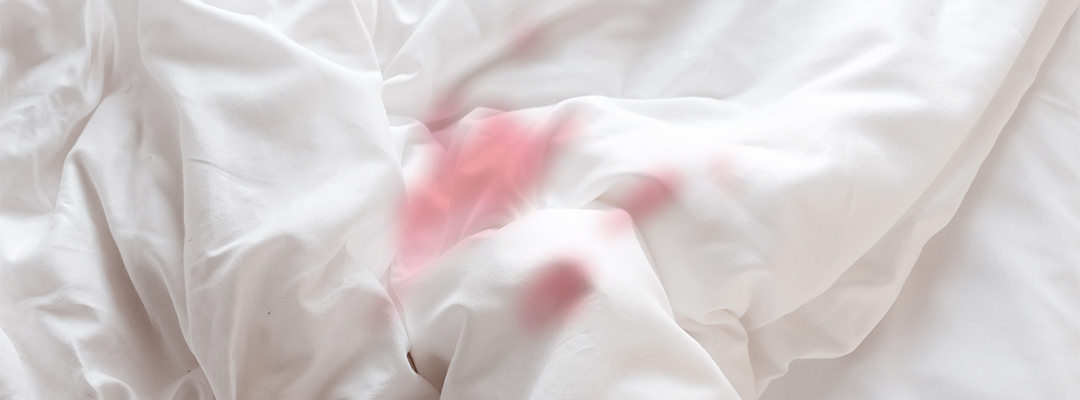If you wake up with blood on your pillow or bed sheets, then the question of “how to get blood out of sheets” is one you need an immediate answer for. If you are prone to nosebleeds or recently had an injury taken care of, but accidentally got blood on your sheets, then you might be worried about getting it out.
Washing blood out of your sheets or pillows is a real concern because it is nearly impossible to take a bloodstain out of material; since blood leaves stubborn stains.
So, How to Remove Blood Stains?
Whatever method you end up choosing, the first thing you need to do is strip the sheets off your bed which will prevent the blood from seeping into the mattress or the comforter. The faster you get the bloodstain off, the better chances of removing the stain as blood is prone to clotting. This means that it will get sticky and become much harder to remove the longer it rests on the sheets.
Rinse the areas of the sheet that have blood on them. The best tip is to always use cold water because contrary to popular belief, it is better at getting bloodstains out than warm water. If you use warm water, you will set the stain into the sheet instead. Focus on getting out most of the blood before you scrub at the stain. Rubbing it with all of the blood inside will spread the blood further into the sheet fibers making it that much harder to remove.
Since one of the next steps is to choose a stain remover, let’s discuss some of the potential ones you can buy or items you can find around the house that might be used as one.
Hydrogen Peroxide
Hydrogen Peroxide is the most popular and easiest way to remove blood from any surface. There are chances that you might have this laying around because there are so many uses for this product. Once you get hold of it, spot test to make sure that it will not bleach your sheets. If there is no change in the color of the sheet for up to fifteen minutes, it is safe for you to use it on your sheets.
Pour the hydrogen peroxide on top of the stain and wait for it to work its magic as you will get to see the process of stain removal; since the liquid will start bubbling on the sheet. Once the bubbling dies down, which usually takes fifteen minutes, clean the sheet with a wet sponge or a tissue. Now the sheet is safe and can be loaded into the washing machine.
Enzyme Remover
Enzyme-based stain removers are great for removing urine, grass, or bloodstains. Spray an appropriate amount of enzyme remover on the stained area and let it sit for fifteen minutes or as per instructions written on the bottle. Using a tissue, a piece of cloth, or a damp sponge; blot the stain. Rinse and repeat as many times as needed and then put the whole sheet through a final wash with your usual detergent and settings.
Vinegar
Vinegar is one of the best natural cleaners and also a great replacement for hydrogen peroxide. The best part is that you probably have vinegar in your house, which means you don’t have to spend additional money on buying stain removers.
Pour a generous amount of vinegar over the stained area and let it sit for up to twenty minutes. Then rinse out the vinegar and wash as you usually would. Avoid using the dryer until you are sure that the whole stain is completely out because you might set it into the sheets.
Lemon Juice and Baking Soda
There is a household hack for almost everything, which means that there is one for blood stain removal as well. All you need to do is mix one part baking soda with two parts lemon juice and let it sit for twenty minutes. Next, dab it off with a clean cloth and water. In the end, give the whole sheet a thorough rinse.
Cornstarch and Baking Soda
Make a simple paste with cornstarch, cold water, and baking soda, and apply it over the stain. Clean the area with a wet sponge. If it doesn’t work once, then repeat it as many times as needed and then wash the sheet with water and detergent to take away any of the remaining stains.
Aspirin
Crush some aspirin tablets and mix them with cold water to create a paste. Using the paste, scrub at the bloodstain with a toothbrush. Wash the sheet once you are satisfied with the stain removal.
Coca-Cola
This is one of the methods that might sound completely bizarre, but it works. Try soaking the stain in Cola and rinsing it with water. Do this at your own risk because the Cola can sometimes damage light fabric so you need to be careful where you are using it. On the other hand, it can be a great alternative to products that could potentially bleach your sheets such as hydrogen peroxide.
You can choose whatever technique is necessary to remove the bloodstain, you can even combine them for a more efficient result. One thing you need to keep in mind is that both enzyme cleaner and hydrogen peroxide come with their instructions, so follow whatever is the most suitable for your sheets. In addition, always remember to do a patch test before dousing your sheets in any of the above-mentioned products and household hacks to save them from getting ruined permanently.
Meat tenderizer
Meat tenderizers “tenderize” meat by dissolving the proteins within it. However, they can also dissolve the proteins within a blood stain.
Use it by making a paste out of one tablespoon of the meat tenderizing powder and two teaspoons of cold water.
The entire blood stain should be covered with paste, which should then be let dry for about an hour.
When the paste has dried, remove it using a cloth moistened with water, and then pat the area dry with a different dry cloth.
FAQ
How do you remove old blood stains?
Soak the stain in cold water for at least an hour because it helps soften up the dried blood. Scrub the area with some detergent and water from both sides of the fabric. If the stain persists, then apply an enzymatic cleaner after some time.
Can vinegar remove bloodstain?
Yes, vinegar is a great household hack for removing fresh bloodstains. Pour some onto the stain and watch the magic happen.
Will bleach get the blood off white sheets?
If your sheet is completely white, you can simply bleach the whole thing to get the blood stains out.
Does toothpaste work on blood stains?
Applying toothpaste to the stain is another popular hack. You simply apply it, let it dry, and then rinse for best results.
How do you get a period stain out of your mattress?
The best way is to pour a generous amount of hydrogen peroxide over the stain and let it sit for twenty-four hours. If the stain persists then try doing it again. Wipe the area with cold water after you are done.
Can OxiClean remove blood stains?
OxiClean does a good job of getting blood out of sheets. You need to run the stain under cold water to rinse out the excess blood and then submerge the sheets in the OxiClean solution. Once the stain disappears, wash the sheets however you usually do with your laundry detergent.
Do bed bugs always leave bloodstains?
When you have bed bugs, they leave blood stains or dark rusty stains on your sheets which is often their fecal matter. There is a high chance that your bed will then be stained with reddish-brown spots. Try some of these home remedies for bed bugs, or call an exterminator.
Are old bloodstains permanent?
Even though it is hard to remove an old and dried blood stain, unless the blood has been set with hot water or heat, removing it might still be possible.
How to get dried blood out of your hair after an accident?
You can try removing it with soap and water but if it doesn’t come off, try using some white vinegar and let it sit in your hair for a bit before rinsing it off.
Will period blood come out of sheets?
If you get to the stain while it is fresh, then you can easily remove it. If it has dried then try soaking it in cold water before applying a stain remover.
Does salt water remove blood stains?
Make a thick paste with salt and cold water, apply it to the stain, and let it sit for 5 to 10 minutes. Then use some more water to rinse out the paste.
How to remove dried blood stains naturally?
Let the stain soak in cold water and then scrub with soap and water.
How do you get blood out of a couch with baking soda?
Make a paste with some cold water, let it sit for 30 minutes, and rinse it.
What is the best stain remover for dried blood?
OxiClean is a heavy-duty stain remover and works great on dried bloodstains.
How do you get blood stains out of sheets without taking them off?
Take some cold water, dab at the stain, then use any stain remover and pat off the excess.
What dissolves dried blood?
Hydrogen peroxide is great at removing dried blood so pour some directly on the stain and dab with a cloth.
Is hydrogen peroxide bleach?
Hydrogen peroxide isn’t bleach but it does have mild bleaching properties.
Conclusion
Nobody wants to wake up to bloody sheets, but life happens. We hope this comprehensive guide helps you keep your bed sheets clean and tidy as we’ve covered every eventuality short of murder! Hopefully, that last category will never apply to you.
Did you like it?4.5/5 (22)





